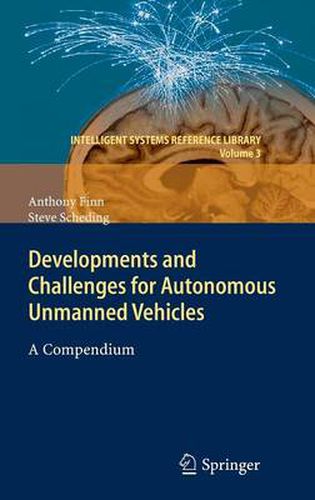Readings Newsletter
Become a Readings Member to make your shopping experience even easier.
Sign in or sign up for free!
You’re not far away from qualifying for FREE standard shipping within Australia
You’ve qualified for FREE standard shipping within Australia
The cart is loading…






This title is printed to order. This book may have been self-published. If so, we cannot guarantee the quality of the content. In the main most books will have gone through the editing process however some may not. We therefore suggest that you be aware of this before ordering this book. If in doubt check either the author or publisher’s details as we are unable to accept any returns unless they are faulty. Please contact us if you have any questions.
It is widely anticipated that autonomous vehicles will have a transformational impact on military forces and will play a key role in many future force structures. As a result, many tasks have already been identified that unmanned systems could undertake more readily than humans. However, for this to occur, such systems will need to be agile, versatile, persistent, reliable, survivable and lethal. This will require many of the vehicles ‘cognitive’ or higher order functions to be more fully developed, whereas to date only the ‘component’ or physical functions have been successfully automated and deployed.
The book draws upon a broad range of others’ work with a view to providing a product that is greater than the sum of its parts. The discussion is intentionally approached from the perspective of improving understanding rather than providing solutions or drawing firm conclusions. Consequently, researchers reading this book with the hope of uncovering some novel theory or approach to automating an unmanned vehicle will be as disappointed as the capability planner who anticipates a catalogue of technical risks and feasibility options against his favoured list of component technologies and potential applications. Nevertheless, it is hoped that both will at least learn something of the other’s world and that progress will ensue as a result.
For the defence policy and decision maker, this is a must-read book which brings together an important technology summary with a considered analysis of future doctrinal, legal and ethical issues in unmanned and autonomous systems. For research engineers and developers of robotics, this book provides a unique perspective on the implications and consequences of our craft; connecting what we do to the deployment and use of the technology in current and future defence systems. Professor Hugh Durrant-Whyte
$9.00 standard shipping within Australia
FREE standard shipping within Australia for orders over $100.00
Express & International shipping calculated at checkout
This title is printed to order. This book may have been self-published. If so, we cannot guarantee the quality of the content. In the main most books will have gone through the editing process however some may not. We therefore suggest that you be aware of this before ordering this book. If in doubt check either the author or publisher’s details as we are unable to accept any returns unless they are faulty. Please contact us if you have any questions.
It is widely anticipated that autonomous vehicles will have a transformational impact on military forces and will play a key role in many future force structures. As a result, many tasks have already been identified that unmanned systems could undertake more readily than humans. However, for this to occur, such systems will need to be agile, versatile, persistent, reliable, survivable and lethal. This will require many of the vehicles ‘cognitive’ or higher order functions to be more fully developed, whereas to date only the ‘component’ or physical functions have been successfully automated and deployed.
The book draws upon a broad range of others’ work with a view to providing a product that is greater than the sum of its parts. The discussion is intentionally approached from the perspective of improving understanding rather than providing solutions or drawing firm conclusions. Consequently, researchers reading this book with the hope of uncovering some novel theory or approach to automating an unmanned vehicle will be as disappointed as the capability planner who anticipates a catalogue of technical risks and feasibility options against his favoured list of component technologies and potential applications. Nevertheless, it is hoped that both will at least learn something of the other’s world and that progress will ensue as a result.
For the defence policy and decision maker, this is a must-read book which brings together an important technology summary with a considered analysis of future doctrinal, legal and ethical issues in unmanned and autonomous systems. For research engineers and developers of robotics, this book provides a unique perspective on the implications and consequences of our craft; connecting what we do to the deployment and use of the technology in current and future defence systems. Professor Hugh Durrant-Whyte